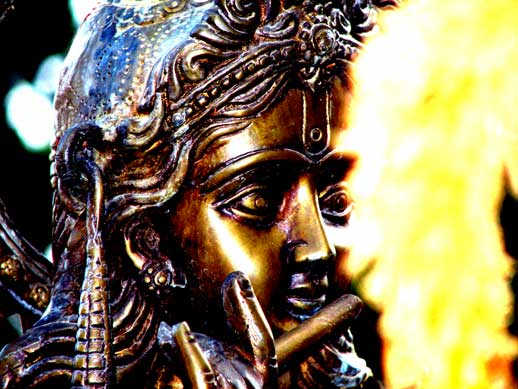 |
|
| You are invited
to submit your questions about the Srimad Bhagavad Gita to Mathaji
Vanamali. vanamali2@gmail.com |
|
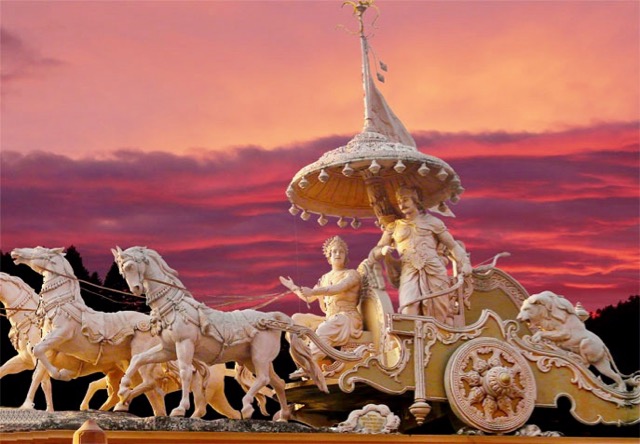 |
|
...the advice of the Gita is given by an avatar or God incarnate. The recipient of the message is Arjuna, the prototype of the struggling human soul who is ready to receive the great knowledge by his close companionship and increasing nearness to the divine Self within himself. This symbolic companionship of Krishna and Arjuna, the divine and the human soul is further dramatized by the fact that their dialogue takes place amidst the din and clamor of a battlefield. The teacher in the Gita is therefore not only the God who is transcendent but also the God in man who unveils Himself through through an increasing knowledge... Vanamali, Nitya Yoga |
|
 Talk given in Malaysia on 15th chapter of
the Bhagavad Gita
April 2008 The main schools of philosophy which
existed at that
time have been synthsised and amalgamated in the Bhagavad Gita. The teacher of the Gita takes up the Sankhya yoga of Iswara Krishna, the Yoga of Patanjali, the Vedanta of the Upanishads and the Bhakti cults of the various Puranas and weaves them into a wonderful practical yoga of its own which is available to all human beings at every stage of their evolution. The second chapter is called Sankhy yoga but actually it deals entirely with Vedanta. The eternal nature of the atman and the ephemeral mature of the body is revealed to Arjuna. "The atman is eternal, immortal, never born and therefor can never die. It is pure consciouness and existence and that which is existant can never cease to exist. This is one of the laws of physics - energy can never be destroyed. it can only change its form. Next Krishna takes the names which appear in classical Sankhya - Purusha and Prakriti. He accepts the Sankhya theory that both are eternal but he differes from the Sankhya in the way he treats their different functions. In classical Sankhya, Purusha is the eternal witness under whose scrutiny Prakriti brings out this amazing cosmos. The two are separate and can never meet. The Gita however divides Prakriti into two parts. One is the gross action and forms of Nature that we see in the world and the universe but beyond that, he says is another Prakriti which is HIS very nature and contains the subtle essence of all creation. that is the womb of all creation and everything gross that we see proceeds from that. But is no different from the Purusha. It is only the active principle of the Purusha and cannot exist without Him. This Praskrit is what He calls the Kshetra in the 13th chapter and the Kshara Purusha in the 15th chapter. It is constantly changing and captivating our minds with its amazing variety. " |
|
|
THE FIELD AND THE KNOWER OF THE FIELD
Extract
of talk given at the Gitashram, Kuala Lumpur on the 16th April, 2006
by Mataji Vanamali  The 13th
chapter of the Srimad Bhagavad Gita, deals with a most modern topic –
The Field. Before the advent of quantum physics, the field was just a
place where grass grew and cows grazed and children played but now it
has come to mean something far more than this. This word, “the field”
has always meant something special in Indian philosophy and especially
in the Bhagavad Gita. In the seventh chapter Lord Krishna says that the
universal field is composed of the five elements, earth, water, fire,
air, ether, and the individual field is composed of our five senses
which correspond to the five elements along with the mind, intellect
and ego. This he says is his lower Prakriti, which is the womb of all
creatures. It is only in the thirteenth chapter that he calls this the
Kshetra or “The Field”. The knower of this field in all its aspects is
the Kshetrajna or the Lord Himself. The idea of such a field is a novel
one in the west. The word came to be used only in the 20th century. The 13th
chapter of the Srimad Bhagavad Gita, deals with a most modern topic –
The Field. Before the advent of quantum physics, the field was just a
place where grass grew and cows grazed and children played but now it
has come to mean something far more than this. This word, “the field”
has always meant something special in Indian philosophy and especially
in the Bhagavad Gita. In the seventh chapter Lord Krishna says that the
universal field is composed of the five elements, earth, water, fire,
air, ether, and the individual field is composed of our five senses
which correspond to the five elements along with the mind, intellect
and ego. This he says is his lower Prakriti, which is the womb of all
creatures. It is only in the thirteenth chapter that he calls this the
Kshetra or “The Field”. The knower of this field in all its aspects is
the Kshetrajna or the Lord Himself. The idea of such a field is a novel
one in the west. The word came to be used only in the 20th century.All scientists are eager to find out about the external world. The scientific mentality is always enthusiastic about discovering everything about this world in which we live. India had an equal number of scientists who were just as eager to know about the external world. The rishis or the great sages of India were scientists but there was a vast difference in their methodology since they were also spiritualists. So even though the first question they asked themselves was “What is this”? Their second question was “Who is this “I” who wants to know”? They realized that without knowledge of the “knower” nothing can be known in its fullness. This is the first mistake made by western science. They tried to eliminate the knower totally from their investigations and for this crime they have had to suffer till the present age. The reason for this was that they created a big chasm between Man, Nature and God. These three were considered to be totally separate entities with no possibility of getting to know each other. The division between science and spirituality arose from this mistake and lasted for a long time. This separation has never existed in India. From the beginning the rishis realized that the foundation of life was spiritual and not material and unless you were able to find the spirit within us we would never be able to fathom the nature of the material world. Thus the Vedic rishis were able to discover a lot of details about the material world which western science took many millenniums to learn. The question may be asked as to why India was not first in the technological field. The fact was that their research into the material world was only a by-product of their research into the inner world. Having conquered the inner, they had no more desire for the trivia of the material world. So they did not pursue their investigations in that particular field. Their only interest lay in attaining that inner world by which they could get liberation from the trammels of earthly life. The western approach to the world was quite different. In order to find out the secrets of nature they ravaged her instead of wooing her. Nature of course is a very harsh mistress and she released her secrets one by one in a very niggardly fashion, always reserving a few up her sleeve. So you find that the history of modern science has been one of discovery after discovery with the previous one being refuted and replaced by another. Even now they haven't come to an end of their research. Their method was to take just a small portion of nature for their critical investigation. The discoveries from this portion were applied to the whole and this resulted in a fragmentary vision of life which is not conducive to a happy and fulfilled life. The rishis on the other hand aimed at a total revelation of truth. True wisdom is a marriage between perfect knowledge and perfect action. Their vision was to get a comprehensive view of reality so their question was always “How do we get to know the one who wants to know? How can we know anything unless we know ourselves”? In the thirteenth chapter, Lord Krishna says that the entire universe is a field for the play of god. This field has two parts. On the universal level it includes the whole of cosmic manifestation and on the individual level it consists of the body, mind, intellect and ego. The first cannot be separated from the other. It is only now that western science is coming to understand this truth. 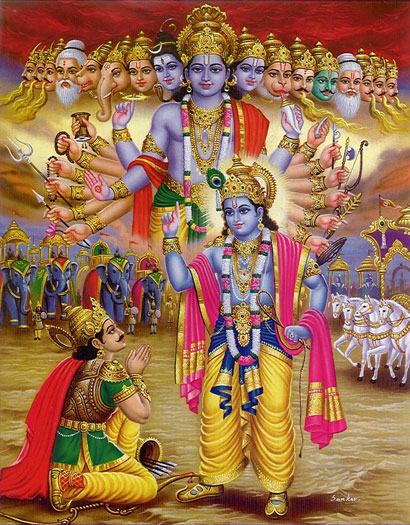 For the next few centuries the church completely dominated the scientific scene so there was no scope for free thought or new ideas. The next great scientist on the western front was Galileo who supported the Copernican view of the heliocentric universe but when he was threatened with torture by the church for his heretical opinions he was forced to give in and say that he had only mentioned these views and did not actually support them! For many centuries after this western science was in abeyance since the church continued to dominate the scene. However with the advent of Newton in the eighteenth century things underwent a dramatic change. The eighteenth century was the age of reason. Newton declared that the universe was a machine with its own implacable, unalterable laws and it would go on working with or without the human being. It was a highly predictable world in which everything could be proved by scientific experiments. God, if he was accepted at all was pictured like a big clock maker who had all the intricate pieces of the clock laid out in an orderly manner so that it ticked on without his help! Man was only a small cog in the universal machine. This was really a big blow to the human psyche which had been reduced to a mere cog from being part of the divine. On the biological field the status of the human being was reduced to an even more pitiable state. Darwin’s views of natural selection and survival of the fittest claimed that evolution was random, purposeless, predatory and solitary. Life was not about sharing and caring but about fighting and surviving somehow or other. Survival of the fittest meant that at the head of the evolutionary cycle stood the terrorist who could be depended upon to stay alive even at the cost of the extermination of the whole human race if need be. This gave rise to a brutal sense of isolation in the human being. This philosophy is what has lead to our peculiar modern psyche which insists that the only way to live is to kill, and exterminate the weaker races so that the strongest would survive. This is what has given birth to the Hitlers and Mussolinis of the world. Children are taught that the eater, eaten being eaten is the law of life so let me eat the other one first before he eats me. But what Darwin missed out totally in his theory of the survival of the fittest is that actually in Nature, the infant of each specie is far from being the fittest and is actually the weakest. It can survive only by the power of love. It’s the mother’s love and tender care which makes the small of each specie to survive against all odds. Thus love is basic to all evolution, basic to the survival of life on this earth. Without love no creature can survive. This is the philosophy which should be ought to our children and not the law of the jungle. Now let us go back to Newtonian physics. The mechanistic view of the Newtonian world was blasted to bits by a young man called Einstein with his simple equation e=mc2. With one stroke of his puny pen, this genius exploded the Newtonian world as effectively as the atomic blast of Hiroshima. His theory of relativity changed the whole concept of an orderly and balanced world which remained static. He declared that matter and energy are inter convertible and therefore there is nothing called matter as we see it. He also gave another blow to Newtonian physics which had always held that Time and Space were eternal verities which depended on nothing else. He affirmed that there was nothing called infinite space and eternal time. They could not exist separately and existed only jointly with each other. He coined the word “space-time” which in modern parlance is known as the 4th dimension. You can imagine what an impact these findings had on western science. People found it hard to believe in the law of relativity even though Einstein proved it with his mathematical formulae. He said that there we nothing absolute in the world. Everything is relative. Actually to the Indian mind this is not such a revolutionary statement. The rishis of India had put the same thing in a slightly different way. They said, “The Absolute alone is Real. Everything else is relative”. Einstein also said that the only certain thing in the world is “change”. The universe we live in is not a static, mechanistic universe but a constantly changing, ever renewing one. This is what the Buddha had declared many millenniums ago. Einstein must surely have been the reincarnation of one of the ancient rishis. The rishis had also known that the stability and reality of matter was only apparent and not real. That is why they called this world of multifarious forms as “Maya” or illusion. In reality, nothing is as it appears to our eyes. Maya means only this – ya-ma- that which does not exist. When our ancient sages with gray beards and strange accents made this pronouncement we shrugged it off as nonsense but when the modern scientists proclaim this we are prone to believe in them even though our senses say this cannot be true. We believe it because they tell us that it can be proved. This is the method of western science that a statement is acceptable only if it can be proved. But very often they found that though they could prove the verity of a statement they were still unable to prove its falsity and according to Indian tradition a thing which cannot be proved false may still be considered as true. For instance we might not be able to prove the existence of God but neither are we able to prove His non-existence. Thus we have no right to categorically declare that He does not exist. At best we can only say that He might or might not exist! Today western science is slowly veering towards the Indian concept of a field of all possibilities in which a thing which cannot be proved need not necessarily be false.  Albert
Einstein
"When I read the
Bhagavad-Gita and reflect about how God created this universe
everything else seems so superfluous." There is a popular science fiction story to explain this idea to the common man. One of a pair of twins was an astronaut and he took a trip to a star twenty-five light years away in a spaceship which could travel almost at the speed of light. The twin brother remained on earth. Fifty years later the earth bound twin who is a grandfather bent with age goes to the spaceport to welcome his brother who bounds down the gangplank. For him only one year had elapsed and he was still young and vigorous. In our Puranas many such stories are given which show that the ancients knew this phenomenon very well and the fact that in astral worlds, time as we know it on earth does not exist. One human year is supposed to be just one day of the gods and in the world of Brahma the creator, one day is an eon on earth. The Bhagavad Purana narrates the story of Revathi, the wife of Balrama, the brother of Krishna. She had been born in the Treta Yuga and had gone with her father to the court of Brahma. They spent only a day there but when they returned to the earth they found that the earth had passed through an incalculable passage of time. It was already in the Dwapara Yuga which was another age according to earthly calculations! Revathi was so tall that her father could not find a man tall enough to marry her since human beings had become much shorter in the Dwapara yuga. Balrama was the only fitting husband for her for he was huge enough to suit her size. Hence the fact that time has only a relative meaning and is not an absolute concept had been recognized long ago in India, Hence Indians have a poor conception of time and are always blamed for their unpunctuality! Even though Einstein had proved that matter and energy were inter-convertible, he had still to discover that energy field. When he died he as on the verge of making another astounding discovery – that of the unified field. His intuition told him that this duality was only apparent and there must exist a unity underlying it but before he could discover that field he died and his work was carried on by those who came after him. . The Puranas describe this zero point field as the Ksheera sagara or the ocean of milk on which Vishnu reposes. In the Devi Purana the Maha Devi has her abode in the middle of this ocean on an island called “The Mani Dwipa”. This ocean is a field of all possibilities. The story of the churning of the ocean is actually an esoteric story which tells us how we create our own worlds. The devas and asuras stand for the positive and negative aspects of the human personality. Using the churn of space called ‘mandara” and the rope of “time” called “ananta” each one churns out for himself whatever he or she wants from life. Many wondrous things come out of this ocean of all possibilities. All types of material goods meant to charm the hearts of the human being appear at the beginning. The wish-fulfilling cow called Kamadhenu, the tree of plenty called the “Ashwattha” and many such enticing things appear one after the other. We run after them in our eagerness to possess them. The world has a thousand things to tempt us and each one can get what he or she desires. But it will be noted that in the story the final thing to come out was the nectar of immortality. If that is our desire it will also be fulfilled.  Another astounding discovery of quantum physics was that the zero point field is beyond space and time. Western science can only guess at these probabilities but Indian yogis have actually experienced this. A yogi who is established in this field can actually know the course of events both in the past and the future. They can even change the course of future events. This is a known fact even in ordinary Indian life. A puja is a ritual in which a god is invoked in order to fulfill certain desires of the devotee. One of the first items in this ritual is called sankalpa. This is the intention with which the person is doing the puja. This may be for passing an exam or getting a good job or anything else. But this sankalpa or intention of the doer is supposed to be so powerful that it can actually change the course of events in the future. Thus in India we realized from the earliest times that the doer of the action or the experimenter is the most important factor which decides the result of the action. Western science tried to divorce the knower from the field of knowledge and tried to reduce the experimenter to the lowest key for it feared that the mind set of the experimenter would change the course of the experiment. They could not accept the fact that without the knower, the field could not be known, in fact it couldn't even exist. Today quantum physics is realizing that it is indeed the mind set of the experimenter which brings to focus everything from this vast field of all possibilities. Without the knower nothing can be known. Even though this seems to be an obvious fact yet strangely enough western science with its insistence on empirical proofs has only now come to an acceptance of this truth. Far from divorcing the experimenter it is only because of the experimenter that the experiment has any possibility of success. Lord Krishna says in the 13th chapter, “Kshetra-kshetrajna yo jnanam tat thwat jnanam matham mama.” “I think that the knowledge of the field and the knower of the field is the only true knowledge.” There is another important difference in western and eastern science. Even though western science seems to be coming closer to many important facts which have always been known in India the fact is that their discoveries are not easily available to the common man. What do all these mathematical formulas mean to the ordinary man? It is said that when Einstein discovered the theory of relativity there were only 9 people in the whole world who understood him. Of course now there are many more, but the fact remains that to the majority of human kind, quantum physics is still a mystery which they are not even interested in unraveling. 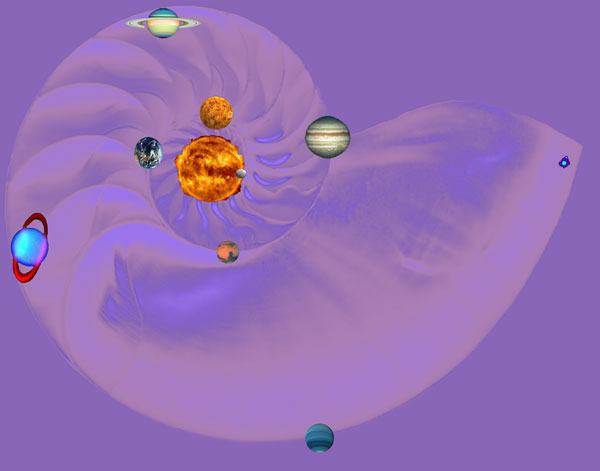 The modern seeker is amazed to find out how much the Vedic seers knew about abstruse subjects like, astronomy, astrology mathematics, botany and so on. They had no scientific equipment or modern technology. Using only the laboratory of their minds they discovered all the secrets of nature, which modern science came to know only at the beginning of the 18th century. Using the techniques of yoga the ordinary mind was enabled to plunge into the level of the cosmic mind or the zero point field through which the yogi could know anything, past, present and future. The yogi who was established on this level of the mind was able to receive direct signals from the cosmic mind. They knew everything only through “manasa vijnana” or the power of the mind. They had answers to questions like, “From which womb does this universe come and into which void does it disappear”? “How is the material world supported by the immaterial space”? And so on. However they were not really interested in acquiring arid facts just for the sake of knowledge. Their inquiries were always directed towards the main purpose of human life which was to gain liberation. Their hearts overflowed with love for the whole of humanity and they searched for a method by which the rest of humanity could benefit from their great discoveries. The result of their experiments is found in the mantras and yantras of the Hindu religion as well as the many paths of yoga and meditation found in the scriptures. They devised a method of living symbols in terms of divine forces. In order to contact these forces they formulated the science of sounds or mantras. A mantra is like a mathematical formula which captures the sound pattern of the deity. In fact they are sound capsules which codify the mysteries of the gods within their sound. These sounds are capable of conveying physical, mental and supra-sensual realities within their frame. What is more important is that these capsules, like the capsules of modern medicine could be used by anyone even without knowledge of their meaning or their purpose. 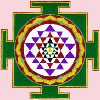 A yantra is a geometrical design which is a storehouse of divine power. All the forms in creation are nothing but condensations of divine energy, and a yantra due to its mathematical precision is a powerhouse of spiritual energy. It is drawn with lines, circles, squares and triangles. Within its concrete form it encloses the uncontrollable power of the deity. It limits the limitless within a figure of criss-cross lines that bind and channel the power of the deity. It creates a field of power that lives, breathes and moves with life because the power of the divine has been invoked into it. The rishis pulled out these yantras from the vast ocean of consciousness, the zero point field that holds within it all conceivable forms. These yantras when placed in a house emit their energy into the atmosphere and change the vibrations within the house. Hence they can be used even by one who knows nothing about its power. It is impossible to imagine how much knowledge and how much compassion the rishis had so that they could invoke the power of the divine thorough their consciousness in a way that could benefit the whole of humanity. Unlike the world of science which is open only to the few who have the intelligence to appreciate it, the magic world which was discovered by our ancients has benefited even the uninitiated from those ancient times to this very day The rishis opened our consciousness to a world of love and beauty and not one of arid facts. 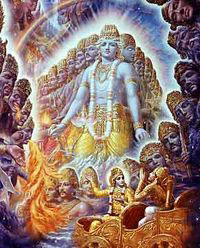 “sarvatha panipadam tat
sarvata shishiromukham, sarvathasrutimanloke, sarvamavritya thishtati.” This Being in whose embrace we live has feet of swiftness and hands of strength on all sides; It has faces, eyes and noses everywhere. It listens to both the throb of the universe as well as the silence of eternity. Though bodiless it has a million bodies. It is the perceiver of all things even though it has no sense organs. It is without attributes yet is the enjoyer and sustainer of all attributes. Attached to nothing, it supports all the action and movement of its Prakriti. It is at once the inner and the outer, the far and the near, the moving and the unmoving. It is the subtlest of the subtle, beyond the grasp of our minds as well as the density of matter which we can see and touch and smell and hear. It is the light of all lights beyond the darkness of ignorance. It is knowledge, the object of knowledge and the goal of knowledge. Despite its greatness it is seated in the hearts of all as the charioteer of our lives! At last the great teacher says to his disciple Arjuna, “O Arjuna, whatever exists whether movable or immovable know it to have come from the union of the kshetra and the kshetrajna, the field and the knower of the field”. This is the knowledge which will carry us beyond death to immortality. It is only when our inner eye opens and we see this truth that we can be called “seers”. This is that supreme consciousness about which western science is still to know. Without knowing that consciousness humankind can never know the meaning of true fulfillment or peace. Hari Aum Tat Sat! |
|
| You are invited
to submit your questions about the Srimad Bhagavad Gita to Mathaji
Vanamali. vanamali2@gmail.com |
|
Question: At every crucial point in the Maha Bharat, Lord Krishna demands that Arjuna do something that is a breach of conventional morality to pursue victory over evil.... Is Krishna teaching that adharma in the pursuit of dharma is justified? Mathaji Vanamali: Answer: Certainly Krishna is not justifying the value of adharma in the pursuit of dharma. In fact you will see that at every point when he appears to be doing this, he is actually saving his devotee from an unrighteous act by doing it himself. God can and will save his devotee from all unrighteousness even at the cost of blemish to his own name. This is the point that one should see. the Pandavas had totally surrendered their lives to Him. Arjuna had chosen Krishna, alone and unarmed instead of the crack regiment of the Yadavas which was offered to him. This was because he had absolute faith that his Lord and Master, God and guru would save him despite all odds, despite all the adharmic acts done by his opponents. These adharmic acts were legion. The Pandavas especially Yudhistira may not have wanted to take revenge but the God to whom he had surrendered his all, would not let the evil doers get off scott free. If you notice in the Mahabharata, every one of these so called adharmic acts were instigated or done by Krishna himself so that his devotee would not have to pay a karmic debt. Such was the love he bore the Pandavas. And such is the love he bears to all who worship him and surrender to him body, mind and ego. I think I did say that all these so called adharmic acts were to ensure and safeguard the life and fortunes of his devotees, the Pandavas who had surrendered their all to Him and had complete faith that He would save them from every crisis. We cannot take the law in our own hands and punish the wrong doer but God can and will do it a hundred times in order to save his devotees and see that justice is done. Now let us take the specific occasions. The killing of Jayadratha which I will take later. As we know Arjuna loved Bhishma more than his own father whom he did not even remember. But he was loathe to be instrumental in killing him. Krishna however had no such qualms. You must remember that all these apparently adharmic acts of Krishna were connected with his role as karmaphaladhata or the giver of the fruits of karma. Let me stress again and again - the law of karma insists that everyone gets their just deserts and also that every one of our desires will be met with. Bhishma's greatest desire was to be killed by Krishna and he had sworn to make Krishna take up his discus. In order to fulfill his devotee's wishes, Krishna had at one time taken up his discus even though he had promised Duryodana not to take up arms and he had rushed at Bhishma as if to kill him. Bhishma was so happy that he had put down his sword and waited with folded palms to accept the discus. this Krishna did in order to instigate Arjuna to Kill Bhishma. Bhishma also loved Arjuna very much but in order to fulfill his role as the general of the Kaurava army he had again and again killed hundreds of people in the Pandava army. There was no question of like or dislike in these actions. He was merely performing his duty as an instrument of the divine will as Krishna had been constantly advising Arjuna to do. Arjuna had been shirking this duty especially when it came to his beloved grand sire so now Krishna drove the horses at a furious pace towards Bhishma and told Arjuna to keep Shikandin in front of him and shoot the fatal arrow at Bhishma. When Bhishma saw Shikandin he refused to retaliate since he had been born a woman and thus both Shikandin's and Arjuna's arrows pierced him and he fell from the chariot. It is for each one to decide if God has the power to retaliate and give just deserts to the people concerned.
Bhima for many years. He had a boon from his mother that he would be invincible if she took off the bandage which was covering her eyes and looked at him. This she was prepared to do for his sake. Unfortunately his sense of modesty refused to allow him to go stark naked before her so he tied a cloth round his waist, which covered his thighs up to his knees in the manner of a wrestler. So when Gandhari took off the bandage round her eyes her gaze took in everything except his thighs. So that was the only weak point in him. Now Bhima had known this fact but during the fight, he quite forgot about it and Krishna had to remind him. Again we must go to the scene just before this to get the correct picture. Duryodana had asked Bhima which his weak point was and Bhima had innocently pointed to his head. Duryodana had given him a huge blow with his mace on his head and Bhima had fallen but somehow he managed to get up. Then he asked Duryodana which his weak point was and Duryo falsely pointed to his own head which was adamantine and impossible to break. so Bhima whacked him on the head and Duryodana roared with laughter and prepared to hit Bhima again on the head which would certainly have finished him off. Bhima cast a desperate glance at his saviour Krishna who slapped his own thighs and immediately Bhima remembered the whole story and lunged at D's thighs just as he raised his mace to bring it down on Bhima's head. So you see that all these dicey stories have been put with a definite purpose, not to belittle Krishna but to show his infinite compassion to his devotees and how he was prepared to save them from their own foolishness. If God is not prepared to save us then why do we pray to him or surrender to him? This is what we have to think of and not take just the surface story. The same thing happens in the Ramayana. We have to realize that the sages who wrote these stories had a definite purpose in their minds. Like the Zen koans we are meant to think over these situations and realize why they have been kept. The other incident is when Jayadratha is brought out of his cave by Krishna covering the sun with his discus. Again to go to the background of the story. Jayadratha was directly responsible for Arjuna's son, Abhimanyu's death. Arjuna had sworn to kill him before sunset or else kill himself. The Kauravas were gleeful when they heard this and they smuggled Jayadratha to a cave and placed enormous hurdles in front of Arjuna to cut off his approach to the cave. At last when it was almost time for the sun to set, Krishna realized that something had to be done in order to save the life of his beloved devotee and so he is supposed to have covered the disc of the sun with his discus and seeing this, Jayadratha crept out of his lair like a jackal. Krishna immediately removed his discus and the sun burst forth in a blaze and Arjuna shot Jayadratha without further ado. If you have read the story of the slaughter of Abhimanyu you will realize that someone who contrived something like that definitely deserved death. Aum Vanamali |
|
| Question: What is the Gita's view on the
individual's relationship to war? Mathaji Vanamali: The Bhagavad Gita does not directly give an answer to this question. It is not concerned with specific questions even though the background is that of the battlefield. Krishna's answers are addressed to the whole of humanity. Arjuna was only the instrument. So His answers cover the whole gamut of an individual's relationship to any problem which confronts him. and not just war. Krishna tells Arjuna and through him to us that a person should follow his swadharma which is the action which is incumbent on him, which both his nature and environment has unfolded in him. Arjuna was a Kshatriya and therefore ruler ship and fighting for a just cause, were both part of his nature and his environment and upbringing. Therefore HIS salvation lay in following the rule of his nature. To go against his nature and run away to the forest to meditate would bring ruin both on him and to the country of which he was the ruler. Arjuna was not a conscientious objector who hated war and wanted to desist from it at all cost. Even in the forest he would be thinking with hatred of Duryodana and wishing he had not missed his opportunity for revenge. His country would once again have been under the rule of the despotic Kauravas and his own evolution would be impaired due to this. One cannot attain liberation by escaping from our swadharma. The path to liberation has to be through the perfect doing of one's swadharma. If Arjuna had been a Brahmin, Krishna's advise would have been totally different. So we see that what Krishna advocates is not war but the faultless performance of one's own duty. Aum Vanamali |
|
| Question: Is it fair to say that Sri Krishna is
the father of the fields
of Transpersonal and Cognitive Psychology Mathaji Vanamali: It would be a lot fairer to say that Sri Krishna is the master of all fields of psychology. He answer to Arjuna's question is one which is a solution to the universal problem of unhappiness and unfulfillment. All psychology tries to solve this type of problem whatever be the name they call it. Traspersonal psychology tries to make the person go beyond the self and discover their greater potential. Jung was a pioneer in this field. Certainly this is the first method advocated by Lord krishna. He told Arjuna to delve into the million dollar question, "Who am I" He goes further to explain to him that the outer personality which we are all familiar with is not our real Self. This is only the small self which is totally conditioned by the environment and education etc. However there is a higher self in all of us which is the Person beyond the personality and this is our true Self and this is what we have to discover if we want abiding happiness. Cognitive psychology helps people to discover what they went wrong in their thinking and helps them to rectify these thinking patterns. In the very first chapter itself Arjuna starts his arguments based on very wrong thinking patterns. He is only seeing a partial view of the problem from his biased and individual view point. "I don't like to fight and perhaps kill by teacher and grand sire". This is no doubt a very legitimate view, you might say but the fact is that Krishna is trying to take him to see a higher view point. Its like an old time general who stations himself on top of a hillock in order to have an overall view of the battle. He is thus able to gauge what should be done where and when and keeps sending messages to the soldiers and captains which might not be understandable to them from their limited stand point on the field. Thus one might say that Krishna is also the father of cognitive psychology. All Hindu philosophy deals with transpersonal and cognitive psychology. All types of yoga encourage the individual to go beyond his personality and discover the Person underlying it which is the true core of his being. So long as we float on the surface of the ocean (our superficial personality) we are sure to be buffeted by the waves. It is only when we dive into the depths that we can come into contact with "the Person" who ever abides in the peace and quiet of the ocean bed. Having understood the Person we can come up to the surface and play with the waves and we will not be harmed by them but until we find this for ourselves we are not capable of dealing with the waves! Aum Vanamali |
|
Question:
In the 4th chapter of the Gita, the Lord speaks of various sacrifices. Offering hearing and other sense functions, daily study of Vedas, austerities, wealth, prana etc as sacrifice. 1. Does this sacrifice mean doing all these things for the sake of God alone without a selfish motive? Is this then the same as what is called Karma Yoga? 2. What is the meaning of this line? Those who partake of nectar, the sacramental remnants of sacrifice, attain to the eternal Brahman. Love and Namaskarams, Nandini Dearest Nandini, When every action is done as a yajna (offering to god; sacrifice) then it becoes karma youga. This is what is meant by prasada buddhi. Anything that comes is taken as prasadam (left over of what has been offeed to God). This applies to not just food offerings but the results of any of our actions. Whatever we get should be consideed as prasadam. This teaches us to accept everything that happens with equanimity and joy since its all His prasadam. Hope I have made it clear. Love and bessings, Amma |
|
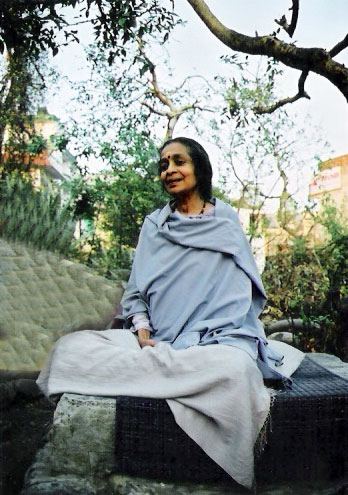 |
|
Garden Gita Discourse at Vanamali Ashram |
About Vanamali Ashram |
Satsang |
Miracle at Vanamali |
Home |
Reason For Rebirth |
Vanamali Love Songs |
 |
||||||
|
